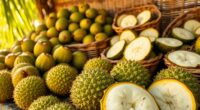The Maldivian cuisine centers on fresh seafood, especially tuna, combined with coconut in various forms like milk, oil, and grated flesh. You’ll find flavorful curries, rice, flatbreads, and snacks such as tuna cakes and coconut fritters, often flavored with aromatic spices like cumin, turmeric, and chili. Coconut plays a essential role, influencing many dishes and traditions. If you want to discover more about how these elements shape Maldivian food, keep exploring the rich culinary heritage.
Key Takeaways
- Maldivian cuisine centers on fresh seafood, especially tuna, combined with coconut in various forms like milk, oil, and grated flesh.
- Traditional dishes include fish curries (*Mas riha*), chicken curry (*Kukulhu riha*), and vegetable curries, served with rice or flatbread (*roshi*).
- Coconut products and aromatic spices such as cumin, turmeric, and chili define the bold, flavorful taste profile of Maldivian food.
- Flatbreads (*Roshi*), snacks like tuna cakes (*Kulhi Boakibaa*), and sweets like banana fritters are key elements of local cuisine.
- Food customs emphasize communal sharing, preservation techniques, and influences from South Asian, Arabian, and East African culinary traditions.
Core Ingredients and Staple Foods of the Maldives
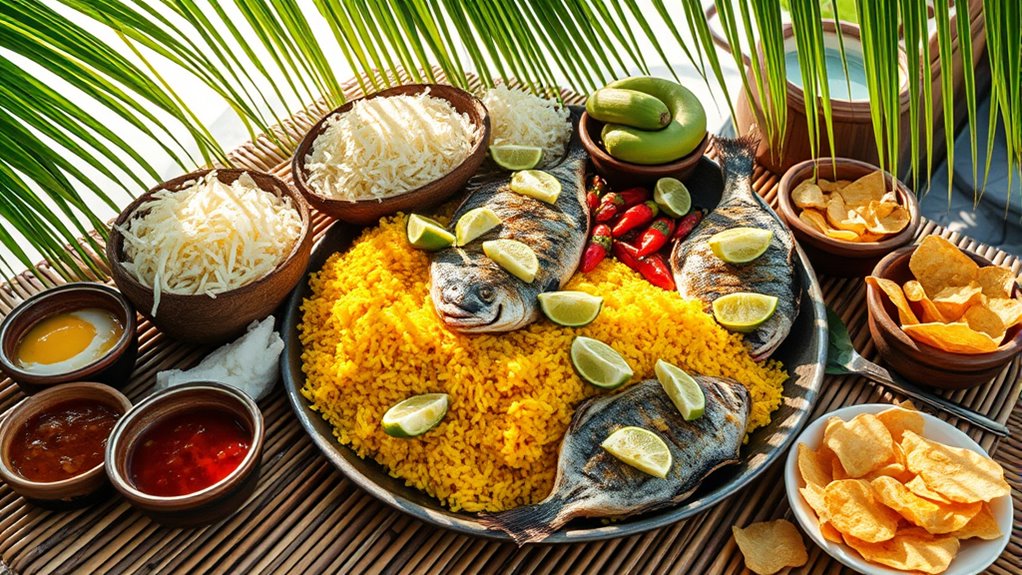
The core ingredients of Maldivian cuisine revolve around fresh seafood, especially tuna, which is the primary protein source. You’ll find it prepared in various ways—fresh, dried, or smoked—adding depth to many dishes. Coconut is just as essential; it appears as grated flesh, milk, oil, and water, enriching curries and beverages. Starches like rice, taro, sweet potato, cassava, and breadfruit form the foundation of most meals, providing energy and texture. Spices such as cumin, turmeric, cardamom, curry leaves, and chili create bold, aromatic flavors. Fresh vegetables and fruits are used seasonally, although some imported produce supplements local shortages. Together, these ingredients define the simplicity, richness, and unique flavor profile that characterize Maldivian cuisine.
Traditional Maldivian Dishes and Curry Varieties

Traditional Maldivian cuisine features a variety of flavorful dishes, with fish curries taking center stage. You’ll find *Mas riha*, a fresh tuna curry, is considered the most essential, packed with spices and coconut milk for richness. *Kukulhu riha*, a chicken curry, offers a different flavor profile, blending aromatic spices unique to the islands. Vegetable curries often include local produce like eggplant, pumpkin, and moringa, enhanced with dried Maldives fish for added depth. These curries are usually served with steamed rice or *roshi*, a simple flatbread. The dishes highlight bold, aromatic flavors influenced by South Asian, Arabian, and East African traditions. Whether you’re enjoying a spicy fish curry or a vegetable medley, these meals reflect the Maldivian love for fresh ingredients and vibrant spices. Additionally, the use of local dried Maldives fish adds a distinctive umami flavor that is characteristic of Maldivian cuisine to enhance flavor.
Flatbreads, Snacks, and Street Food Delights
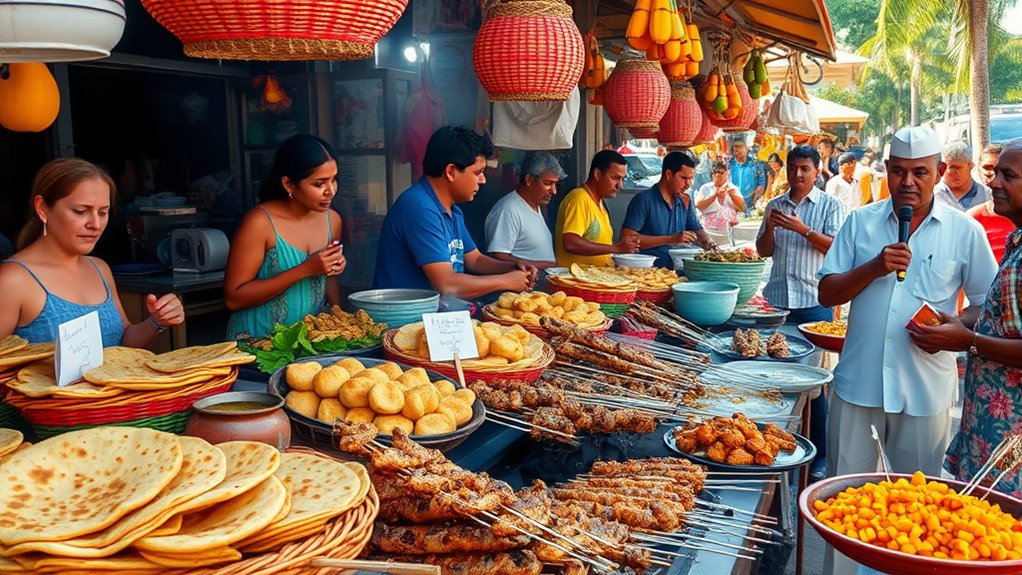
Flatbreads and snacks play a vital role in Maldivian cuisine, offering quick, flavorful options that reflect local ingredients and culinary ingenuity. You’ll find *roshi*, a simple flatbread made from flour, salt, and vegetable oil, cooked on a stovetop and often enjoyed with curries or as a snack. *Masroshi* takes this further, stuffing *roshi* with tuna, coconut, chili, and spices before pan-frying to perfection. Street vendors serve popular bites like *Kulhi Boakibaa*, savory tuna cakes with ground rice and coconut, and *Bis Keemiya*, spiced turnovers akin to samosas. Deep-fried banana and coconut fritters, called *Dhonkeyo kajuru*, are sweet treats, while *Bonda Bay* features sweet rice drizzled with rose syrup. These snacks embody the vibrant, resourceful spirit of Maldivian street food culture. Additionally, the use of local ingredients such as coconut and tuna showcases the resourcefulness and adaptability of Maldivian culinary traditions.
The Role of Coconut in Maldivian Cuisine
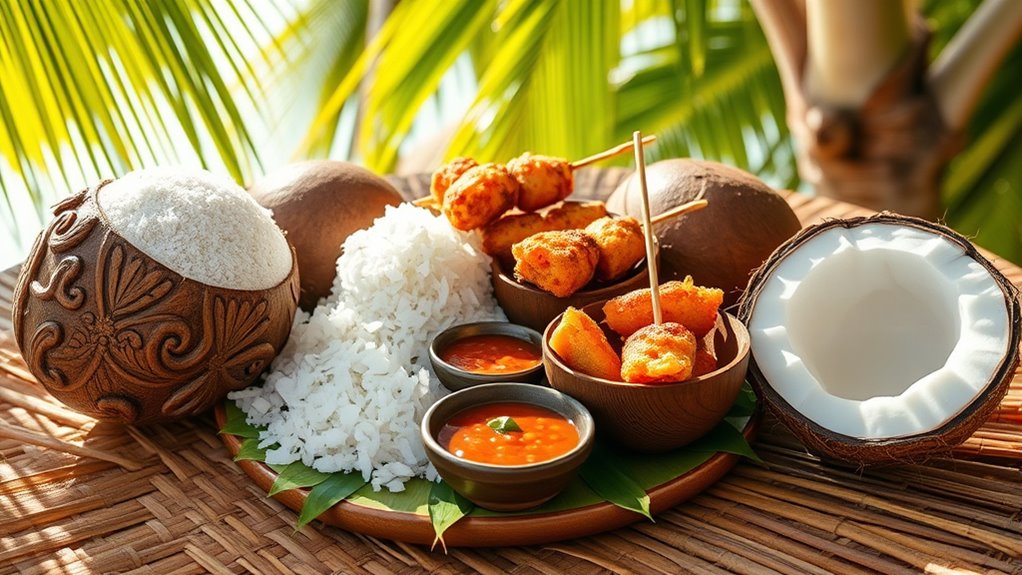
| Coconut Form | Common Dishes | Purpose |
|---|---|---|
| Milk | Curries, Soups | Creamy texture and flavor |
| Grated | Breakfast, Snacks | Texture and aroma |
| Water | Drinks, Remedies | Hydration and health |
| Oil | Frying, Cooking | Adds richness and flavor |
| Coconut in Maldivian cuisine also plays a vital role in cultural heritage by preserving traditional recipes and cooking methods.
Distinctive Flavors and Culinary Influences
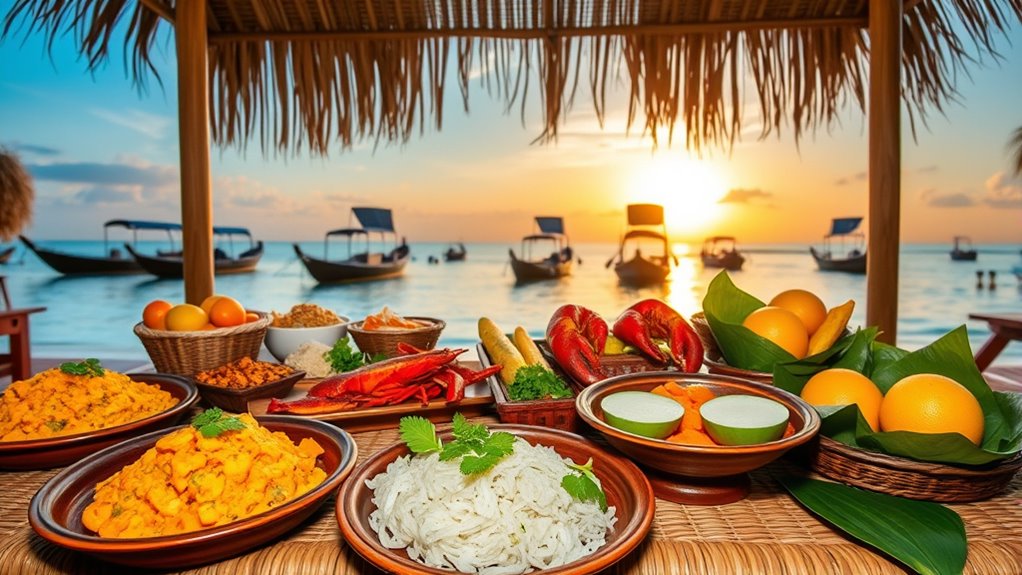
Maldivian cuisine showcases a rich blend of flavors that reflect its geographic and cultural crossroads, drawing influences from South Asia, Arabia, and East Africa. You’ll notice bold, aromatic spices like cumin, turmeric, and cardamom, which add warmth and depth to dishes. The use of chili provides a gentle to fiery heat, balancing the richness of coconut milk and fish. Fermented seafood products like rihaakuru contribute a savory umami flavor unique to the islands. You’ll also find curry leaves, garlic, and cinnamon in many recipes, highlighting the aromatic complexity. These culinary influences come together to create a distinctive taste profile that’s both bold and harmonious, emphasizing fresh seafood, tropical spices, and coconut-based ingredients that define Maldivian flavors. Additionally, the cultural significance of food in Maldivian society emphasizes community and tradition, making culinary practices an integral part of local celebrations and daily life.
Food Culture, Eating Habits, and Celebratory Foods

You likely notice that Maldivian meals revolve around fish, rice, and coconut, reflecting their traditional practices. During festivals and special occasions, families come together to enjoy dishes like honey-infused coconut bars or sweet rice with rose syrup. These celebrations highlight their strong food customs and the importance of shared eating habits in maintaining cultural identity. Additionally, the use of coconut in cuisine underscores its significance in Maldivian culinary traditions.
Traditional Meal Practices
Traditional meal practices in the Maldives reflect a deep connection to the sea and local ingredients, with meals often centered around fish, rice, and coconut. You’ll find that meals typically follow a simple yet flavorful structure, emphasizing fresh, local produce.
- Fish, especially tuna, is prepared as curries, dried, or smoked to suit different dishes.
- Rice or flatbreads like *roshi* serve as the main starchy component, often accompanied by vegetable curries.
- Coconut, in various forms, enriches dishes like *Mas Huni* and adds creaminess to curries.
- Meals are shared communally, with fish-based curries paired with rice or flatbread, highlighting a tradition of hospitality and simplicity.
Festive Food Celebrations
Festive food celebrations in the Maldives are vibrant events that highlight the island nation’s rich culinary heritage. During these occasions, you’ll find traditional dishes like *Bondi*, sweet coconut bars infused with honey, and *Bonda Bay*, a fragrant rice dessert with rose syrup. Special gatherings often feature large shared meals of tuna curries, such as *Mas riha*, paired with fluffy *roshi* or steamed rice. You might also enjoy *Kulhi Boakibaa*, savory fish cakes, and street snacks like *Bis keemiya*. Coconut plays a central role, from rich curries to sweet treats. These celebrations emphasize communal dining, where families and communities come together, sharing flavors and stories. The festive foods reflect Maldivian history, blending local ingredients with cultural influences from South Asia, Arabia, and East Africa. Glycolic acid is also used in some skincare routines to enhance skin radiance and clarity.
The Impact of Geography and Local Resources on Food Choices
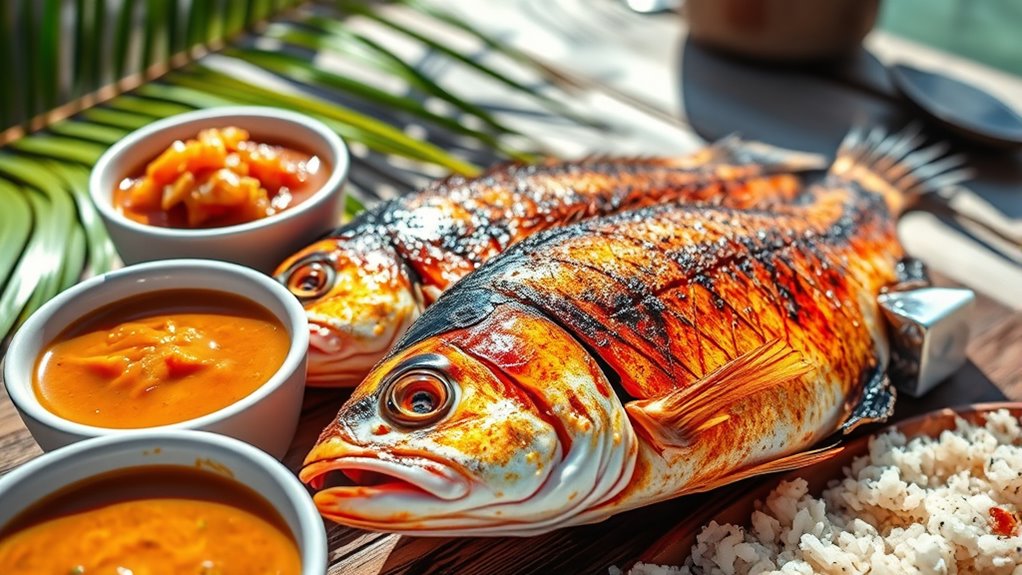
The unique geography of the Maldives, consisting of over 1,000 coral islands spread across the Indian Ocean, directly shapes your food choices. First, you rely heavily on seafood, especially tuna, which is abundant and forms the core of many dishes. Second, coconuts are essential; they provide milk, oil, and grated flesh for cooking and flavoring. Third, limited land means you depend on starchy staples like rice, breadfruit, and taro, often imported or cultivated in small patches. Lastly, your access to fresh vegetables and fruits is seasonal or supplemented by imports, influencing your diet’s variety. This geography encourages a cuisine rooted in seafood, coconut, and resilient staple foods that adapt to the island environment.
Frequently Asked Questions
How Do Maldivian Cuisine Influences Reflect Its Historical Trade Relationships?
You can see Maldivian cuisine’s influences through the bold spices and ingredients used, reflecting trade with South Asia, Arabia, and East Africa. You’ll notice the use of aromatic spices, coconut, and fish products, which reveal historical trade links. These elements blend local traditions with foreign flavors, creating a unique culinary identity that’s shaped by centuries of maritime trade and cultural exchange, making the cuisine rich, diverse, and historically connected.
What Traditional Methods Are Used to Prepare and Preserve Maldives Fish?
You might find it fascinating that Maldivian fish is traditionally prepared and preserved through drying, smoking, and salting, methods passed down through generations. These techniques help prolong freshness amid the island’s humid climate. You’ll notice that dried Maldives fish is often added to curries for flavor, while smoking imparts a rich aroma. These age-old practices ensure a steady supply of seafood, even when fresh fish isn’t available.
How Do Seasonal Variations Affect Ingredient Availability in Maldives?
Seasonal changes in Maldives influence ingredient availability considerably. You’ll find fresh vegetables like eggplants and gourds more abundant during certain seasons, while tropical fruits may be imported when local harvests are scarce. Fish catches can fluctuate, affecting the freshness of seafood. To adapt, you might use preserved or dried ingredients, or rely on imported produce, ensuring your dishes stay flavorful year-round despite seasonal variations.
What Are the Common Dietary Restrictions or Vegetarian Options in Maldivian Food?
You’ll find that Maldivian cuisine is heavily fish and coconut-based, so vegetarian options are limited. However, you can enjoy vegetable curries with eggplant, pumpkin, and leafy greens, often enhanced with dried fish or seafood flavors. Many dishes are naturally vegetarian or can be adapted by skipping seafood. It’s common to see rice, flatbreads, and vegetable sides, making vegetarian meals possible, though fish remains a staple in most traditional dishes.
How Do Maldivian Culinary Traditions Incorporate Modern or International Flavors?
You might be surprised how Maldivian cuisine blends modern and international flavors effortlessly. As you explore, you’ll find local chefs incorporating ingredients like cheese, pasta, and even fusion spices into traditional dishes like curries and snacks. This creative mix keeps the cuisine dynamic, reflecting global influences while respecting island flavors. So, when you taste Maldivian food, you’ll experience a delightful harmony of age-old traditions and contemporary culinary trends.
Conclusion
So, next time you indulge in Maldivian cuisine, remember it’s a feast built on simple ingredients like coconuts and fish—hardly the stuff of gourmet fantasies. Yet, somehow, these humble elements create flavors that captivate the world. It’s amusing how a tiny island nation’s culinary pride rests on such modest staples, proving that sometimes, the most unassuming ingredients can deliver the most unforgettable tastes. Truly, simplicity never tasted so extraordinary.


